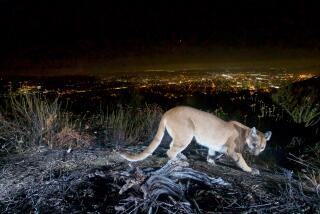Mountain lion makes itself at home in Griffith Park
Smack in the middle of Los Angeles, feasting on deer and roaming the chaparral-covered slopes, a mountain lion prowls Griffith Park.
Yes, there had been sporadic rumors over the years of the 140-pound beasts lurking in the shadows of populated hillsides near the parkâs attractions, but wildlife biologists had discounted them because of the improbability of the animals crossing the freeways to get there.
For the first time, however, scientists now have photographic evidence of a lion inhabiting the park. His name is P-22. Thatâs P, as in puma.
PHOTOS: A mountain lion in Griffith Park
âWe never had any definitive proof of a mountain lion living in Griffith Park,â said Jeff Sikich, a National Park Service biologist. âWe believe this is pretty significant, that itâs surrounded by such intense urbanization.â
Park-goers were surprised â and intrigued. âThatâs crazy,â said Edwin Bulaon, 42, of Tujunga, on learning of the cat as he finished riding his bicycle through the park Monday.
Sitting in her car reading a book, 27-year-old Monica Marroquin wasnât surprised. âI always thought they were here,â Marroquin said.
The good news for anxious hikers and cyclists is that mountain lions, also known as pumas or cougars, are solitary creatures that usually avoid human contact. P-22 has not been sighted near toddlers in Travel Town or riders at the Equestrian Center, and biologists say heâs not likely to be.
âI think thereâs a greater risk from hopping in your car and driving on the 101 ⌠than getting attacked by a lion,â Sikich said.
The journey of P-22 was no walk in the park, even if it landed him in one.
In an odyssey of perhaps 20 miles, the cat had to cross concrete and backyards, dodge commuter traffic and thread an obstacle course of culverts, bridges and roads.
Biologists say the 3-year-old lion probably came from farther west in the Santa Monica Mountains in mid-February.
Sikich and other scientists surmised that P-22 might have traversed a bridge or culvert to cross the 101 and 405 freeways to enter the park. Itâs possible, however, that the cat sprinted across lanes of traffic â and got very lucky. In a study of the 405, scientists have documented two deaths of lions killed by motorists.
Sometime after P-22 entered the park, he triggered a remote camera set up for a general wildlife survey.
Photo in hand, Sikich set out to catch him. He installed three humane traps in the area. He also set up a camera at each trap, rigged to send any images to his cellphone if triggered.
Nine days later, at 2 a.m., his cellphone rang. He and other scientists raced to the site, a Department of Water and Power property just west of the park.
Sikich used a blowpipe to administer a sedative. The team spent about an hour gathering samples and taking measurements. Most important, they attached a collar with both GPS and very high frequency radio signal technology so they could track where and when the lion made his kills.
They woke the animal and released him.
The GPS function went dead, however, leaving the researchers with only radio telemetry to generally track the felineâs peregrinations.
In recent weeks, Sikich has used radio frequencies to attempt to zero in on the lionâs whereabouts so he can recapture him and apply a new collar. So far, the beast has eluded him by ranging throughout the parkâs wild lands and over the ridge toward Forest Lawn Memorial-Park.
On Monday, Sikich dragged a frozen deer through the DWP land near where he had just approximated the lionâs location, hoping to lure him.
P-22 has made a home in the rugged backcountry of the park, and there he remains, surrounded by the ceaseless roar of traffic and the clatter of urban life, perhaps even with an occasional view of the downtown Los Angeles skyline.
The discovery of P-22 puts to rest persistent questions about the possibility of a lion in the park. In 1995, a homeless man led a California Department of Fish and Game warden to a dead cougar lying about 20 feet off the road, near a park ranger station. And the L.A. Department of Recreation and Parks posted warning signs in 2004 in response to reported sightings.
But biologists have dismissed most reports as bobcats mistaken for lions, or just wild talk.
Now, they say, proof of a lion in the park could shed light on new behavioral patterns for the animals. âGriffith Park is so tiny, yet we have this young male mountain lion in there,â Sikich said. âWeâre really interested in how he got there, how long he will stay and, if and when he chooses to leave, how he will cross these freeways.â
Sikich is part of a National Park Service team that has captured and collared more than 20 cougars in the Santa Monica Mountains during a decadelong study.
The photos taken in mid-February were the first known images of any mountain lion within the mountain system east of Cahuenga Pass, the National Park Service says. Preliminary genetic analysis by UCLA indicates that P-22 is probably related to the coastal mountain group.
At about eight square miles, Griffith Park is a fraction of the 300-square-mile territory that a mature male lion would typically rove. Sikich figures the parkâs plentiful mule deer helped draw the lion.
âI was excited, but I wasnât surprised,â said Gerry Hans, president of Friends of Griffith Park. The nonprofit group is a major funder of a study of animal movements in and out of the park being conducted jointly by theU.S. Geological Surveyand Cooper Ecological Monitoring Inc. Cooper set up 15 cameras along the 101 and in the surrounding hills â one of which captured the P-22 images.
PHOTOS: A mountain lion in Griffith Park
Friends of Griffith Park members expressed some safety concerns at first. âBut the more we learned, the more comfortable we were with having a mountain lion in the park,â Hans said. âI think heâs OK with the park, and weâre OK with him.... Heâs doing the right things, the things that mountain lions do, mainly eating deer.â
Far from wishing the lion gone, he said, many people said they wanted to ensure that P-22 does not end up like the lion that recently wandered into downtown Santa Monica and was killed by police after efforts to subdue him failed.
How much longer P-22 will call Griffith Park home is uncertain.
âSoon heâs going to want to mate with a female,â Sikich said. âI presume heâll start searching for one if he hasnât already, and that might draw him outside Griffith Park.â
Times staff writer Ruben Vives contributed to this report.
More to Read
Sign up for Essential California
The most important California stories and recommendations in your inbox every morning.
You may occasionally receive promotional content from the Los Angeles Times.











